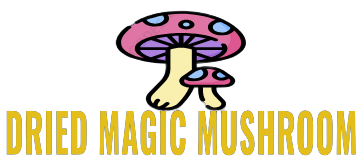Crystal meth, DMT, Ecstasy, LSD
DMT and Anxiety. Does DMT Help With Depression and Anxiety?
DMT Depression and Anxiety

Despite being a controlled drug, DMT is being considered to treat mental conditions, such as depression and anxiety.
Popularly called spirit molecule, N, N-dimethyltryptamine, or DMT, is a hallucinogenic tryptamine drug.
DMT has no approved medical use in the United States but can be used by researchers under a schedule I research registration that requires approval from both U.S. Drug Enforcement Administration and the Food and Drug Administration.
Despite being a controlled drug, DMT is being considered to treat mental conditions, such as depression and anxiety.
- It is a schedule I controlled substance, which makes it illegal to possess, distribute, manufacture, and buy the drug.
- There is a high chance for abuse and are no safety parameters surrounding the use of the drug.
- Like other psychedelic substances, such as lysergic acid diethylamide (LSD) or magic mushrooms, DMT produces an intense auditory and visual hallucinogenic experience.
What is DMT?
Dimitri or N, N-dimethyltryptamine (DMT) is a white crystalline powder that can be brewed, smoked, or vaporized to have orally or snorted, or injected into the bloodstream.
- The powder is derived from plants, such as Psychotria viridis and Banisteriopsis caapi, which are native to South America, Mexico, and some parts of Asia.
- DMT is the active ingredient in ayahuasca, which is a traditional plant medicine from Amazonia that was believed to bring spiritual enlightenment.
The chemical structure of DMT is pretty similar to sumatriptan, which is an antimigraine drug.
DMT can be produced naturally in the body by the pineal gland.
Upon consumption, DMT can cause its effects quickly. Plant-based brews can produce effects within 20 to 60 minutes, whereas the effects of synthetic DMT can kick in about 5 to 10 minutes.
What are the side effects associated with DMT?
Upon consumption of N, N-dimethyltryptamine (DMT), the primary effects consist of intense hallucinogenic experiences that cause complete alteration of the reality around them.
Most of the effects are psychological and physical. Users describe that DMT causes brief auditory and visual hallucinations where they supposedly travel to other realms and experience an alternate reality.
The side effects that are generally associated with DMT include:
- Moderate to severe chest pain and severeness
- Increased heart rate
- Agitation or paranoia
- High blood pressure
- Rapid movements of the eye or dilated pupils
- Dizziness
Out of all the psychedelic drugs present out there, DMT supposedly produces the least side effects. The side effects of DMT depend on the user. It can range from mild exciting experiences to frightening ones.
Can DMT be used to treat mental health problems?
Small-scale studies have produced evidence that psychedelics have therapeutic benefits in disorders that have rumination, habits, and bias as key symptoms, such as depression, substance abuse, and posttraumatic stress disorder.
- A recent study indicates that N, N-dimethyltryptamine (DMT) can be potentially used to treat depression and anxiety along with therapies.
- Findings from nonclinical studies suggest DMT can help reduce behavioral despair in the forced swim test, which is a well-recognized animal model of depression.
Due to the powerful hallucinogenic effects produced by DMT, medical professionals believe that this drug can be used for those who do not produce desirable results to conventional treatments of depression.
Psychedelic-assisted therapy may provide long-lasting relief, and because DMT produces the least side effects than other psychedelic drugs, it is the preferred choice for study.
- The most striking positive in the use of psychedelics to treat depression is the longevity of its effects. Psychedelic-assisted therapy, based on the research evidence, is likely to have an immediate onset of antidepressant activity, which will be long-lasting for about three to six months.
- DMT must be administered in moderation to treat depression. The drug is supposed to help improve the different pathways of the brain by activating different serotonin receptors across the cortex, which will inhibit the normal processes of unhealthy thought in the brain.
- The pathways could be then “reset” with the help of different therapies, thus providing an opportunity for them to resettle differently.
DMT is a powerful drug that can produce hallucinations that are linked to near-death experiences. Therefore, to use it to treat mental health conditions, more research needs to be done to completely solidify the claims.
Regulations should be strictly laid down for the use of DMT. Some people may have untoward side effects, such as bad trips, worsened symptoms, or adverse effects on the heart.
dmt and anxiety
What Is N, N-Dimethyltryptamine?
N, N-Dimethyltryptamine is the full chemical name of a drug known as DMT.
DMT is a hallucinogenic tryptamine derivative that is currently a DEA Schedule I controlled substance.
Schedule I means that this drug has no acceptable medical use. Drugs in this category also have a high chance of being abused. DMT is untested for consumer use and is banned by the FDA.
DMT is a psychedelic substance. This indole alkaloid can naturally be found in some plant species in Mexico, South America, and parts of Asia. DMT may also be produced in a lab.
In its pure form, DMT is a white crystalline powder or solid. It can be a yellow, orange, or pink solid when it is not pure. When combined with ayahuasca, it can be a brownish-red liquid.
Some common slang names for DMT include; Dimitri, the spirit molecule, businessman’s trip, fantasia, and 45-minute psychosis.
It is often compared to other psychedelic drugs such as; LSD, ketamine, and magic mushrooms.
DMT has been used since ancient times, most commonly in ritual contexts. It has been around for thousands of years as part of South American shamanic ceremonies. For religious purposes, DMT is used to achieve higher spiritual consciousness.
DMT is legal in some countries only for these religious purposes.
However, beginning in the mid-1900s, tryptamines like LSD and DMT started to be used recreationally by young people.
Because of the potency and unpredictable nature of DMT, the use of this drug can be dangerous and may affect one’s mental and physical well-being.
The effects of DMT are similar to those of psychedelics like LSD.
Research also suggests that DMT is endogenous, meaning it originates within the body of a living organism.
According to the NIH, endogenous hallucinogens like DMT, 5-hydroxy-N, N-dimethyl-tryptamine, and 5-methoxy-N, N-dimethyltryptamine (5-MeO-DMT) are acknowledged as naturally occurring components of the mammalian body.
However, it is difficult to recall what their biological functions are.
DMT and ayahuasca are commonly mistaken for the same thing.
Ayahuasca’s main part is DMT . Ayahuasca contains MAOIs, which prevent enzymes in your body from breaking down DMT which plays a role in its hallucinogenic effects.
DMT causes intense hallucinations.
Hallucinations involve seeing, hearing, smelling, feeling, or even tasting things that are not real. Hallucinations commonly occur in people diagnosed with mental illnesses such as schizophrenia and bipolar disorder.
However, substance use can also cause hallucinations to occur.
Experiences with DMT differ based on the user. Some report excitement, while others feel extremely frightened.
Often, the user will experience mental side effects for days or even weeks after using the drug because of its strength.
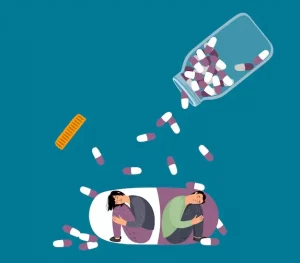
What Is The Pharmacology Behind DMT?
DMT works by blocking the action of serotonin in the brain.
Tryptamines refer to a broad class of classical or serotonergic hallucinogens. Serotonergic hallucinogens are drugs that affect serotonin, which is a substance that acts as a neurotransmitter and carries signals throughout your body.
Serotonin regulates mood, digestion, sleep, and other important bodily functions. When serotonin levels in your body are too little or too high, it can negatively affect your mental and physical health.
DMT acts as a non-selective agonist at most or all serotonin receptors, specifically at the 5-ht2a receptor.
Stimulation of this receptor may help induce the hallucinogenic effects of DMT. At the same time, the serotonin produced inhibits both dopamine and adrenaline.
Dopamine is a neurotransmitter that is involved in neurological and physiological functions.
Dopamine plays a role in the brain’s “reward center” and impacts functions such as; memory, movement, mood, attention, and others.
The hallucinogenic effects of DMT differ depending on the way it is taken and the dose of DMT.
When DMT is taken alone, it is usually snorted, smoked, or injected.
The effects of DMT come faster when injected through the vein or muscle, as opposed to taking the drug orally.
When smoked, the effects of DMT may happen immediately. It is hard to determine how long it takes to reach peak effects when DMT is smoked.
When consumed as a brew in ayahuasca, the effects may take longer and peak around 2 to 3 hours.
When taken orally, DMT has to be combined with monoamine oxidase inhibitor (MAOI) to break down. An example of an MAOI is the ayahuasca vine. MAOIs intensify the pharmacological effects of DMT.
Side effects of DMT may include:
- Vivid hallucinations
- Depersonalization
- Distorted sense of time
- Increased/rapid heart rate
- Increased blood pressure
- Chest pain or tightness
- Agitation
- Dizziness
- Pupil dilation
There are also serious risks that can potentially come with taking DMT which include:
- Persistent psychosis
- Confusion
- Seizures
- Loss of muscle coordination
Psychosis is a symptom characterized by disruptions to someone’s thoughts and perceptions, making it difficult to recognize what is real and what is not real.
According to the DEA and American Association of Poison Control data, coma and respiratory arrest have also been associated with DMT, especially in higher doses.
Many people who have used DMT have reported that their experience is life-changing. This can include mystical encounters or near-death experiences.
Frontiers in Psychology describe near-death experiences (NDEs) as episodes that occur in association with death or the perception that death is about to come.
To determine the degree to which DMT induces NDEs, a rating scale was created called the NDE scale.
According to this scale, the results suggest a strong overlap between DMT AND NDEs.
The use of psychedelic drugs may also cause something called ego death. Ego death refers to momentarily forgetting who you are and what everything is. This can lead to a drastic change in someone’s perception of life.
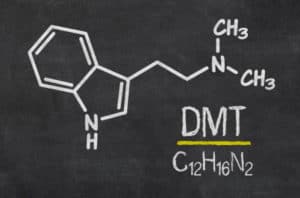
Is DMT A Hallucinogenic?
Yes, DMT is a hallucinogenic tryptamine drug.
Hallucinogens are widely abused.
According to the Substance Abuse and Mental Health Services Administration, in 2016, about 114,000 adolescents aged 12 to 17 were current users of hallucinogens. Additionally, 668,000 young adults aged 18 to 25 used hallucinogens as well.
Hallucinogens are commonly divided into two categories: classic hallucinogens and dissociative drugs.
DMT is considered a classic hallucinogen, along with LSD, peyote (Mescaline), and Psilocybin. Examples of dissociative drugs include; Ketamine, PCP, Salvia, and DXM.
Hallucinogens refer to drugs that cause hallucinations, which are distortions in a person’s perception of reality.
According to the NIH, Hallucinogens distort the way someone perceives time, color, motion, sense, and self.
People who take hallucinogenic drugs often report intense emotional swings, seeing images, hearing sounds, and feeling things that seem real but are not.
Hallucinogenic drugs are also associated with psychotic-like episodes that can continue to occur for a long time after the person has taken the drug.
According to SAMHSA, It is also possible for teens to develop an addiction or tolerance to hallucinogens. For example, if a teen uses a hallucinogen regularly, they would need to take more and more every time to feel its effects.
Addiction or tolerance to hallucinogens can lead to risky behavior that may potentially result in injury or death because of an altered perception of reality.
Drug use can have a significant impact on a teen’s developing brain.
Permanent results of repeated drug use in teens can include:
- Lower IQ
- Permanent loss of memory
- Loss of coordination
- Additional mental health disorders
If you suspect a teen or loved one is abusing DMT or any other type of substance, it is important to educate yourself and reach out for professional help.
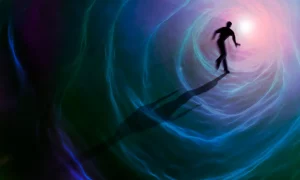
Does DMT Help Depression?
Because DMT is so strong, it can affect both your physical and mental health.
DMT works similarly to antidepressants, targeting the serotonin receptors in the brain.
People who consume large amounts of DMT or take DMT along with antidepressants are at risk for developing serotonin syndrome.
Serotonin syndrome is potentially life-threatening and caused when you take too much of a drug that heightens the levels of serotonin in your body.
Symptoms of serotonin syndrome may include:
- Anxiety
- Disorientation
- Restlessness
- Excitement
- Tremors
- Rapid heart rate
- Abnormally rapid breathing
- Shivering
- Diarrhea
Some recent studies may suggest that DMT may be effective as a depression treatment. According to Pharmaceuticals, more research is needed to determine whether DMT is a safe and effective treatment for depression.
Dr. Rick Strassman is currently a Clinical Associate Professor of Psychiatry at the University of New Mexico School of Medicine. His research involved DMT and was led to this substance by studying the pineal gland as a potential biological point for spiritual experiences.
In his book, The Spirit Molecule, he makes the case that DMT is naturally released by the pineal gland and facilitates the soul’s movement in and out of the body.
How Does DMT Affect Anxiety?
DMT and hallucinogens may trigger people with existing mental health problems
Because of its significant effect on the brain and its chemistry, DMT can worsen anxiety, depression, and other mental health conditions.
It can intensify the symptoms that come along with anxiety, such as; rapid breathing, feeling nervous, panicking, or having trouble thinking about anything other than what you are currently worrying about.
Because it is hallucinogenic, the user may also experience a “bad trip.” This can include uncontrollable vivid hallucinations and experiencing terrifying visuals. Those who already have mental health problems are more at risk of experiencing a “bad trip.”
On the contrary, there is a discussion about the use and safety of DMT and psychedelics as a treatment for mental health disorders like anxiety and depression.
More research is needed to determine the effectiveness, risks, and safety of DMT as a treatment.
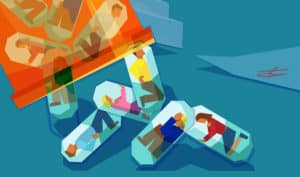
Are Psychedelics Legal?
Psychedelics fall into the Schedule I category making it illegal to make, buy, possess, distribute, or consume.
More recently, some cities in the U.S. are decriminalizing DMT; however, it is still illegal under state and federal law.
Psychedelics fall in the Schedule I category because they have a high potential for abuse and no accepted medical use.
Possession of DMT can lead to legal consequences, including prison or fines.
Additionally, similar to drunk driving, driving under the influence of drugs is also illegal and dangerous. Not only can it lead to legal consequences, but it can also have fatal consequences.
What Are Other Types Of Psychedelics?
Psychedelics are a class of psychoactive substances that alter perception, mood, and cognitive processes.
Other types of psychedelics include:
- LSD
- Ayahuasca
- Psilocybin
- Ecstasy
- Mescaline
What Is LSD?
LSD stands for lysergic acid diethylamide.
Like DMT, LSD is a hallucinogen that has a high potential for abuse and has no currently accepted medical use in the United States.
LSD is a synthetic drug, meaning it is man-made.
When taking LSD, users may experience extreme visual changes and mood changes. It can also create a distorted perception of time and depth along with the shape of objects, colors, sounds, movements, and even body image.
Other physical effects of taking LSD may include:
- Dilated pupils
- Increased body temperature
- Increased heart rate and blood pressure
- Sweating
- Dry mouth
- Loss of appetite
- Tremors
The effects of LSD depend on the user; what environment they are in, their personality, their mood, and expectations. The use of LSD can lead to terrifying thoughts and fears and create flashbacks that occur even after someone takes the drug.
According to MedlinePlus, LSD can also lead to mental health problems such as anxiety, depression, and schizophrenia.
LSD alters the user’s mind and affects the central nervous system. It affects the brain’s chemical serotonin, which helps control behavior, mood, senses, and thinking.
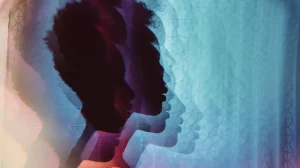
What Is Ayahuasca?
Ayahuasca is a psychoactive brew made from the leaves of Psychotria Viridis and the stalks of Banisteriopsis caapi.
The Banisteriopsis caapi vine contains potent MAOI’s called harmine, with is a beta-carbolize and harmala alkaloid. This reduces the breakdown of DMT and may impact its psychoactive effects.
The Psychotria Viridis plant contains DMT, which causes hallucinogenic effects.
Ayahuasca itself is not a hallucinogen; the DMT in it is.
Ancient Amazonian tribes used this brew for spiritual and religious purposes.
People may use ayahuasca to create a psychedelic experience.
Traditionally, it was used by shamans as a ritual.
Some people try mind-altering substances like ayahuasca to try and overcome their fears and go deeper into their minds.
Many of the effects of ayahuasca are psychological.
The effects of ayahuasca may include:
- Euphoric feelings
- Hallucinations
- Extreme fear
- Paranoia
- Gastrointestinal symptoms such as vomiting and diarrhea
There is no way to predict how someone will react to the use of ayahuasca.
The effects of DMT last longer when consumed in an ayahuasca tea because it is absorbed through your stomach lining.
According to Frontiers in Pharmacology, research may suggest that ayahuasca can be helpful for people struggling with PTSD and healing traumatic memories. However, because of limited research, safety and effectiveness are still in question.
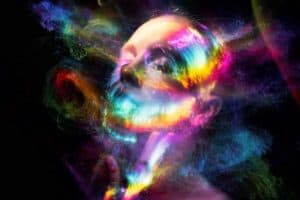
What Is DMT Music?
Some people who use hallucinogens include music listening with the expectation that the music will help provide a better experience.
Some believe that music may help create a more spiritual experience as well.
There is no specific selection of music that is meant or certain experiences with hallucinogens. The type of music listened to differs from person to person.
Traditionally, ayahuasca is used during shamanic rituals and ceremonies. During these ceremonies, the shamans would use various instruments like drums or pipes.
More recently, electronic dance music (EDM) festivals are growing in popularity among young adults. At these festivals, the widespread use of novel or new psychoactive substances (NPS) is documented.
Novel psychoactive substances are newly available drugs, including synthesized hallucinogens.
Examples of NPSs may include; mitragynine, synthetic cannabinoids, dimethyltryptamine and novel serotonergic hallucinogens, and ketamine and novel dissociative drugs.
NPSs differ from classic psychedelics because they lack the history of human use and research that investigates their safety.
People who take these drugs at festivals may hope to enhance their music appreciation and overall experience.
According to a study done by Forensic Science International, approximately 75% of the population included in the sample tested positive for at least one biological specimen for drugs or alcohol.
Of that 75%, over one-third of those attendees were confirmed to contain one or more NPS or MDMA.
The use of drugs in settings like this can be dangerous and result in adverse events and fatalities.
Hallucinogens are unpredictable, and the use of them in unfamiliar or overstimulating settings can put someone more at risk of a “bad trip” and other negative health effects.
Especially for young people and the developing brain, the use of drugs can cause serious permanent damage to one’s mental and physical well-being
dmt in the brain
DMT — or N, N-dimethyltryptamine in medical talk — is a hallucinogenic tryptamine drug. Sometimes referred to as Dimitri, this drug produces effects similar to those of psychedelics, like LSD and magic mushrooms.
DMT is a Schedule I controlled substance in the United States, which means it’s illegal to make, buy, possess, or distribute it. Some cities have recently decriminalized it, but it’s still illegal under state and federal law.
Does it have other names?
Sometimes people use other names to refer to DMT. These street names include:
- Dimitri
- fantasia
- businessman’s trip
- businessman’s special
- 45-minute psychosis
- spiritual molecule
Where does it come from?
DMT naturally occurs in many plant speciesTrusted Source, which have been used in religious ceremonies in some South American regions for centuries.
It can also be made in a laboratory.
Is it the same thing as ayahuasca?
Kind of. DMT is the main active ingredient in ayahuasca.
Ayahuasca is traditionally prepared using two plants called Banisteriopsis caapi and Psychotria viridis. The latter contains DMT while the former contains MAOIs, which prevent certain enzymes in your body from breaking down DMT.
What does it feel like?
As with most drugs, DMT can affect people in very different ways. Some truly enjoy the experience.
Others find it overwhelming or frightening. Some refer to this negative experience as a bad trip.
As far as its psychoactive effects, people have described feeling like they’re traveling at warp speed through a tunnel of bright lights and shapes. Others describe having an out-of-body experience and feeling like they’ve changed into something else.
There are also some who report visiting other worlds and communicating with alien-like beings.
Some people also report a pretty rough comedown from DMT that leaves them feeling unsettled.
How is it consumed?
Synthetic DMT usually comes in the form of a white, crystalline powder. Sometimes the drug can have a yellowish or pinkish color.
It can be smoked in a pipe, vaporized, or snorted. DMT can also be injected, but this method is said to come with additional risks.
When used in religious ceremonies, plants and vines are boiled to create a tea-like drink of varying strengths.
How long does it last?
Synthetic DMT kicks in pretty fast. It often produces effects within just a few minutes, but can take up to 10 minutes.
Plant-based brews tend to produce effects within 20 to 60 minutes.
The intensity and duration of a DMT trip depends on several things, including:
- how much you use
- how you use it
- whether you’ve eaten
- whether you’ve taken other drugs
Generally, the effects of inhaled, snorted, or injected DMT last for about 45 to 60 minutes.
Drinking it in a brew like ayahuasca can leave you tripping for anywhere from 2 to 6 hours.
Does it cause any side effects?
DMT is a powerful substance that can cause a number of mental and physical side effects. Some of these are desirable, but others not so much.
Possible mental effects of DMT include:
- euphoria
- floating
- vivid hallucinations
- altered sense of time
- depersonalization
Keep in mind that some people experience lingering mental effects for days or weeks after use.
Physical effects of DMT can include:
- rapid heart rate
- increased blood pressure
- visual disturbances
- dizziness
- dilated pupils
- agitation
- paranoia
- rapid rhythmic eye movements
- chest pain or tightness
- diarrhea
- nausea or vomiting
Are there any risks?
Yes, some of them potentially serious.
DMT’s physical side effects of raising both heart rate and blood can be risky, especially if you have a heart condition or already have high blood pressure.
Using DMT may also cause:
- seizures
- loss of muscle coordination, which increases the risk of falls and injury
- confusion
It may also be associated with respiratory arrest (when someone stops breathing) and coma.
Long-term effects
Like other hallucinogenic drugs, DMT may cause persistent psychosis and hallucinogen persisting perception disorder (HPPD). HPPD is more commonly known as “flashbacks.” Both are rare and may be more likely to occur in people with preexisting mental health conditions.
Serotonin syndrome warning
DMT can result in high levels of the neurotransmitter serotonin. This can lead to a potentially life threatening condition called serotonin syndrome disorder.
People who use DMT while taking antidepressants have a higher risk for developing this condition. Some other medications and supplements are also associated with serotonin syndrome.
Seek immediate medical attention if you’ve used DMT and experience the following symptoms:
- confusion
- disorientation
- irritability
- anxiety
- muscle spasms
- muscle rigidity
- tremors
- shivering
- overactive reflexes
- dilated pupils
Any other interactions to know about?
DMT can interact with a range of other prescription and over-the-counter medications, as well as other drugs.
If you’re using DMT, you should avoid mixing it with other substances such as:
- alcohol
- opioids
- cocaine
- amphetamines
- cannabis
- LSD, aka acid
- mushrooms
- ketamine
- gamma-hydroxybutyric acid (GHB), aka liquid V and liquid G
Prescription and over-the-counter medications to avoid mixing with DMT include:
- opioids
- antihistamines
- muscle relaxants
- vasodilators
- blood pressure medications
- benzodiazepines
- antipsychotics
Is it addictive?
The jury is still out on whether DMT is addictive, according to the National Institute on Drug AbuseTrusted Source.
What about tolerance?
Tolerance refers to needing to use more of a particular drug over time to achieve the same effects. Based on researchTrusted Source, DMT doesn’t appear to cause tolerance.
Harm reduction tips
DMT is extremely powerful, even though it naturally occurs in several plant species. If you’re going to try it, there are a few steps you can take to reduce your risk for having a bad reaction.
Keep these tips in mind when using DMT:
- Strength in numbers: Don’t use DMT alone. Do it in the company of people you trust.
- Find a buddy: Make sure you have at least one sober person around who can intervene if things take a turn.
- Consider your surroundings: Be sure to use it in a safe and comfortable place.
- Take a seat: Sit or lie down to reduce the risk of falling or injury while you’re tripping.
- Keep it simple: Don’t combine DMT with alcohol or other drugs.
- Pick the right time: The effects of DMT can be pretty intense. As a result, it’s best to use it when you’re already in a positive state of mind.
- Know when to skip it: Avoid using DMT if you:
- are taking antidepressants or another medication associated with serotonin syndrome
- are taking a medication that interacts with DMT
- have a heart condition
- have high blood pressure
The bottom line
DMT is a naturally occurring chemical that’s been used for centuries in religious ceremonies in several South American cultures. Today, its synthetic form is used for its powerful hallucinogenic effects.
If curious about trying DMT, it’s important to take certain steps to reduce your risk for serious effects. This includes making sure any prescription or over-the-counter medications you take won’t cause a bad reaction.
If you’re concerned about your drug use, there’s help available. If you feel comfortable, you can bring it up to a doctor. Keep in mind that patient confidentiality laws will prevent them from reporting this information to law enforcement.

DMT and the Pineal Gland: Separating Fact from Fiction

The pineal gland — a tiny pine cone–shaped organ in the center of the brain — has been a mystery for years.
Some call it the “seat of the soul” or the “third eye,” believing it holds mystical powers. Others believe it produces and secretes DMT, a psychedelic so powerful that it was dubbed the “spirit molecule” for its spiritual awakening–type trips.
Turns out, the pineal gland also has several more practical functions, like releasing melatonin and regulating your circadian rhythm.
As for the pineal gland and DMT, the connection is still a bit of a mystery.
Does the pineal gland actually produce DMT?
It’s still TBD at this point.
The idea that the pineal gland produces enough DMT to produce psychoactive effects came from the popular book “DMT: The Spirit Molecule,” written by clinical psychiatrist Rick Strassman in 2000.
Strassman proposed that the DMT excreted by the pineal gland enabled the life force into this life and on to the next life.
Trace amounts of DMT have been detectedTrusted Source in the pineal glands of rats, but not in the human pineal gland. Plus, the pineal gland might not even be the main source.
The most recent animal studyTrusted Source on DMT in the pineal gland found that even after removing the pineal gland, the rat brain was still able to produce DMT in different regions.
What if I ‘activate’ my pineal gland?
That’s unlikely to happen.
There are people who believe you can activate the pineal gland to produce enough DMT to experience an altered state of consciousness, or open your third eye to heighten your awareness.
How does one achieve this activation? It depends on whom you ask.
There are anecdotal claims that you can activate your third eye by doing things like:
- yoga
- meditation
- taking certain supplements
- doing a detox or cleanse
- using crystals
There’s no evidence that doing any of these stimulates your pineal gland to produce DMT.
Plus, based on those rat studies, the pineal gland isn’t capable of producing enough DMT to cause psychoactive effects that alter your intuition, perception, or anything else.
Your pineal gland is tiny — like, really, really tiny. It weighs less than 0.2 grams. It would need to be able to rapidly produce 25 milligrams of DMT to cause any psychedelic effects.
To give you some perspective, the gland only produces 30 micrograms of melatonin per day.
Also, DMT is quickly broken down by monoamine oxidase (MAO) in your body, so it wouldn’t be able to naturally accumulate in your brain.
That’s not to say these methods won’t have other benefits for your mental or physical health. But activating your pineal gland to increase DMT isn’t one of them.
Is it found anywhere else in the body?
Potentially. It seems that the pineal gland isn’t the only thing that might contain DMT.
Animal studiesTrusted Source have found INMT, an enzyme required for the production of DMT, in various parts of the brain and in the:
- lungs
- heart
- adrenal gland
- pancreas
- lymph nodes
- spinal cord
- placenta
- thyroid
Isn’t it released during birth? What about the whole birth and death thing?
In his book, Strassman proposed that the pineal gland excretes large amounts of DMT during birth and death, and for a few hours after death. But there’s no evidence that it’s true.
As far as near-death and out-of-body experiences go, researchers believe there are more plausible explanations.
There’s evidence that endorphins and other chemicals released in high amounts during moments of extreme stress, such as near death, are more likely responsible for the brain activity and psychoactive effects that people report, like hallucinations.
The bottom line
There’s still a lot more to uncover about DMT and the human brain, but experts are forming some theories.
So far, it seems that any DMT produced by the pineal gland likely isn’t enough to induce the psychedelic effects associated with using DMT.

Adrienne Santos-Longhurst is a freelance writer and author who has written extensively on all things health and lifestyle for more than a decade. When she’s not holed up in her writing shed researching an article or off interviewing health professionals, she can be found frolicking around her beach town with husband and dogs in tow or splashing about the lake trying to master the stand-up paddle board.
DMT is a hallucinogen that packs a pretty fast and powerful trip.
Powerful as it is, it appears to have the lowest side effect profile compared with other psychedelic drugs like LSD and magic mushrooms (psilocybin).
Still, DMT carries some risks.
Healthline does not endorse the use of any illegal substances, and we recognize abstaining from them is always the safest approach. However, we believe in providing accessible and accurate information to reduce the harm that can occur when using.
What are the negative side effects?
It’s hard to predict how you’ll react to using DMT because it depends on several factors, including:
- your weight
- your body composition
- the state of your physical and mental health
- how much you take
- how you take it
People take DMT and other psychedelics to experience effects like euphoria, increased creativity, and spiritual insight. It’s known as the “spirit molecule,” after all.
Not everyone enjoys these effects, though. Some people report feeling like they’re having a near-death experience or traveling to another world or dimension (and not in a fun way).
Other negative side effects of DMT include:
- hallucinations, often involving elf-like creatures or alien beings
- distorted sense of time and body
- agitation
- uneasiness
- anxiety
- paranoia
- dilated pupils
- visual disturbances
- rapid rhythmic eye movements
- increased heart rate and blood pressure
- dizziness
Are there any risks linked to it?
DMT does come with some potential psychological and physical risks.
Psychological risks
Like most hallucinogens, DMT has the potential to take you on a bad trip, which can be overwhelming and terrifying. People have reported being left shaken by a bad DMT trip for days, weeks, and even months.
Taking a higher dose increases your chances of a bad experience, as does using DMT if you’re in a negative frame of mind.
DMT may also worsen preexisting mental health conditions, particularly schizophrenia.
Hallucinogens also carry a small risk of persistent psychosis and hallucinogen persisting perception disorder (HPPD), according to the National Institute on Drug AbuseTrusted Source.
Physical risks
Increased heart rate and blood pressure are both side effects of DMT, which can be bad news if you already have a heart condition or high blood pressure.
According to the Drug Enforcement Administration (DEA), DMT can also cause seizures and loss of muscle coordination. It’s been linked to coma and respiratory arrest as well.
What about interactions with other drugs?
Before using DMT, it’s important to know how it interacts with other substances.
Other hallucinogens
Using DMT with other hallucinogens like LSD or magic mushrooms can make an already strong trip even more intense.
Stimulants
Taking DMT with stimulants like amphetamines or cocaine may heighten DMT-related feelings of fear or anxiety.
Opioids
DMT shouldn’t be taken with opioids, especially tramadol, because of an increased risk of seizure.
Antidepressants
Using DMT while taking antidepressants, especially monoamine oxidase inhibitors (MAOIs), can result in a serious condition called serotonin syndrome.
Serotonin syndrome signs
Symptoms of serotonin syndrome include:
- confusion and disorientation
- anxiety
- irritability
- shivering
- tremors
- muscle spasms
- muscle rigidity
If you or someone else experiences these systems during or after DMT use, call 911.
Is it addictive?
Research on its long-term effects is limited. Based on the data available so far, DMT is unlikely to cause tolerance, dependence, or physical addiction.
People who regularly use DMT may crave it psychologically, but this is based on anecdotal reports.
Is it legal?
Nope.
In the United States, the DEA considers DMT a Schedule I controlled substance. This means it’s illegal for recreational use, is deemed to have no current medicinal use, and has a high potential for misuse. That’s the case in most other parts of the world, too.
However, things can get a little muddy when it comes to the plants that contain DMT, like those used to make ayahuasca. These are legal to possess in some countries, including Brazil, Peru, and Costa Rica.
Safety tips to keep in mind
If you’re going to use DMT, there are a few things you can do to reduce your chance of having a bad trip or negative reaction.
Keep the following in mind:
- Strength in numbers. Don’t use DMT alone. Do it in the company of people you trust.
- Find a buddy. Make sure you have at least one sober person around who can intervene if things take a turn.
- Consider your surroundings. Be sure to use it in a safe and comfortable place.
- Take a seat. Sit or lie down to reduce the risk of falling or injury while you’re tripping.
- Keep it simple. Don’t combine DMT with alcohol or other substances.
- Pick the right time. The effects of DMT can be pretty intense. As a result, it’s best to use it when you’re already in a positive state of mind.
- Know when to skip it. Avoid using DMT if you’re taking antidepressants, have a heart condition, or already have high blood pressure.
The bottom line
DMT may not produce as many side effects as other hallucinogens, but that doesn’t mean it’s entirely safe.
Like other drugs, its effects can be unpredictable. No two experiences are exactly alike.
If you’re going to use DMT, take precautions to make the experience as safe as possible. Make sure you know about any potential interactions with other substances you use, including any medications.
dmt elves
The term machine elf was coined by ethnobotanist Terence McKenna for the entities he encountered in DMT “hyperspace”, also using terms like fractal elves, or self-transforming machine elves. McKenna first encountered the “machine elves” after smoking DMT in Berkeley in 1965.
dmt street names
| Drug Type | Street Names |
|---|---|
| Ayahuasca | Aya, Hoasca, Yagé |
| DMT (N,N-Dimethyltryptamine) | Dimitri, The Rogan, The Spirit Molecule |
| GHB (Gamma-Hydroxybutyric) | Date Rape Drug, G, Geeb, Georgia Home Boy, Grievous Bodily Harm, Liquid E |
| Ketamine | Blind Squid, Cat Valium, Green, Jet, K, K-Hold, Kay, Special K, Super Acid, Vitamin K |
dmt mechanism of action
DMT blocks the action of serotonin (a transmitter of nerve impulses) in brain tissue. It is inactive when taken by mouth and produces effects only when injected, sniffed, or smoked. The hallucinatory action begins about five minutes after administration by injection and lasts for about an hour.
what is dmt meditation
DMT Meditation: The guide to channeling your endogenous DMT. Humans have extraordinary abilities that range from the physical to the mental and spiritual. The pineal gland within the human brain is responsible for producing and releasing a natural powerful psychedelic molecule known as DMT, dimethyltrptamine
dmt comes from what plant
Major plant genera containing DMT include Phalaris, Delosperma, Acacia, Desmodium, Mimosa, Virola, and Psychotria, but DMT has been found even in apparently innocuous sources, such as leaves of citrus plants (Servillo et al., 2012), and in the leaves, seeds, and inner bark of mimosa tenuiflora, which has become a
